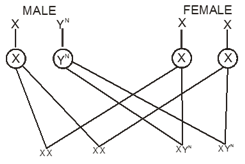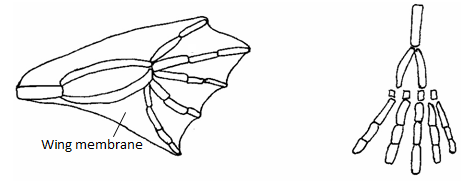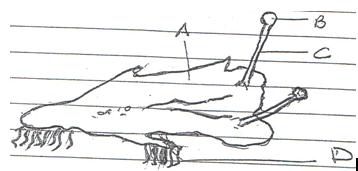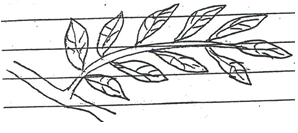SECTION A
- In human beings, baldness is controlled by a dominant gene N located on the Y chromosome
- Work out a cross between a bald headed man and his wife (4mks)
-
- What is the probability of the couple getting girls who would develop baldness (1mk)
- Girls 0% (Zero)
- Give a reason for your answer in b i) above. (1mk)
- Girls do not inherit the Y chromosome from their fathers which carry the gene /girls inherit only X chromosome from their fathers which does not contain the gene. OWTTE
- What is the probability of the couple getting girls who would develop baldness (1mk)
- Apart from the above trait name two other sex linked traits in human beings associated with Y chromosome. (2mks)
- Hairy Pinna;
- Hairy Nose ; Any two; Marks first two
- Work out a cross between a bald headed man and his wife (4mks)
- The diagram below shows structures of the bat wing and human arm.
- These structures are thought to have same ancestral origin. State one structural similarity and one adaptational difference between the two.
- Structural similarity. (1mk)
- Both show the pentadactyl limb structure;
- Adaptation difference. (2mks)
- Human arm has five digits separated into four fingers and an opposable thump for grasping;
- The bat wing has five digits which are long and spread apart to support a large membranous wing for flight;
- Structural similarity. (1mk)
- Give two other examples of structures in nature that show the type of evolution as in (a) above. (2mks)
- Different shapes and sizes of beaks in birds;
- Different feet structure in birds;
- Distinguish between the terms ‘chemical evolution’ and ‘organic evolution’. (2mks)
- Chemical evolution explains the origin of life as having occurred when simple chemical compounds reacted to form the simplest life forms; organic evolution is the progressive development of complex organisms from simple pre-existing life forms over a long period of time;
- What is the study of fossils called? (1mk)
- Palaeontology;
- These structures are thought to have same ancestral origin. State one structural similarity and one adaptational difference between the two.
- The diagram below shows a synapse.

- Indicate the direction of the impulse on the diagram. (1 mark)

- from left to right;
- Label D and E (2 marks)
- D –mitochondrion; rej plural E - Synaptic vesicle ;
- Compare a simple reflex action with a conditioned reflex action. (3 marks)
Simple reflex
Conditioned reflex
Single reflex bring about response
Repeated stimulus to bring about response;
Simplest form of behavior and is independent of experience
Involve modification of behavior and dependent on experience;
Sensory and motor components are the same at all times
Primary sensory component is replaced by a secondary sensory component but the motor component remains unchanged;
- State two functions of hormones in animals. (2 marks)
- regulate growth and development;
- control behavior of animals during breeding;
- enhance proper functioning of the cells ;(any 2)
- Indicate the direction of the impulse on the diagram. (1 mark)
- Science club members designed an experiment as shown below. Examine it
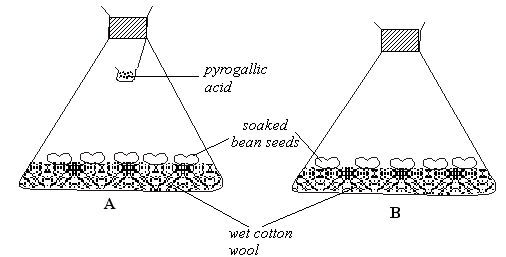 .
.
The set up was kept at room temperature for one week.- What was the aim of the experiment? (1mark)
- To show that oxygen is necessary for germination;
- What observation was made after one week.in A and B (2marks)
- Bean seeds in A did not germinate; while those in B germinated;
- Explain the role of water in seed germination. (3marks)
- Hydrolyse the food; activate enzymes; transport the food to growing regions;
- What was the role of pyrogallic acid in the above set up? (1mk)
- Absorb oxygen;
- Name one internal factor necessary for seed germination (1mk)
- Enzyme.
- Hormones
- Viability
- What was the aim of the experiment? (1mark)
- The diagram below represents a certain organism observed by a student in an ecological tour.
- Name the parts labeled A and C (2mks)
- A-thallus.
B – capsule;
- A-thallus.
- Name the division to which the organism belongs (1mk)
- Bryophyta;
- Give two observable reasons for your answer in (b) above (2mks)
- Presence of rhizoids;
- Presence of thallus;
- Show alternation of generation, gametophyte and sporophyte;
- Define the following terms
- Taxa (1mk)
- Classification units; a group of organisms with similar characteristics;
- Binomial nomenclature (1mk)
- Assigning of TWO scientific names to a living organism;
- assigning a genus and species name to a living organism;
- Taxa (1mk)
- Give the name of the following leaf form observed in plants (1mk)
- Pinnate;
- Name the parts labeled A and C (2mks)
SECTION B.
- An experiment was carried out to investigate the effect of temperature on the rate of reaction catalyzed by an enzyme. The results are shown in the table below
Temperature in (0C) Rate of reaction in mg of products per unit time 5 0.2 10 0.5 15 0.8 20 1.1 25 1.5 30 2.1 35 3.0 40 3.7 45 3.4 50 2.8 55 2.1 60 1.1 - On the grid provided draw a graph of rate of reaction against temperature ( 6 mks)
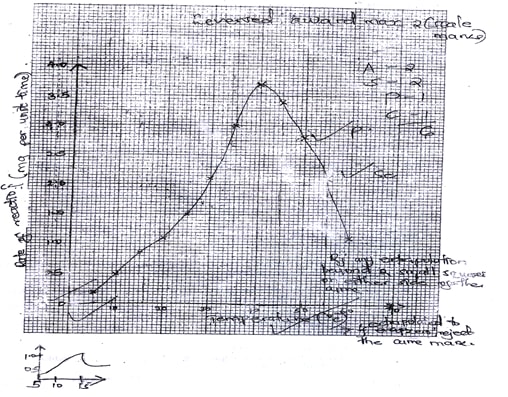
- When was the rate of reaction 2.6 mg of product per unit time? ( 2 mks)
- 330C and 51.5 ( ± 0.50C)
- 32.5 - 33.5 and 51.0 – 52.0
- Account for the shape of the graph between
- 50 C and 400 C ( 2 mks)
- As temperature is increased rate of reaction is increased/ more products are formed (per unit time) because enzymes become more active
- 450 C and 600C ( 3 mks)
- As temperatures increases rate of reaction decreases less products are formed (unit per time) because enzymes become denatured by high temperatures.
- 50 C and 400 C ( 2 mks)
- Other than temperature name two ways in which the rate of reaction between 50C and 400C could be increased ( 2 mks)
- Increase in enzyme concentration and substance concentration
Rj. Increasing number of enzymes
Acc. Increasing number of enzyme
- Increase in enzyme concentration and substance concentration
-
- Name one digestive enzymes in the human body which works best in acidic condition ( 1 mk)
- Pepsin, remain/ chymosin
- How is the acidic condition for the enzyme named in (e) (i) above attained? ( 2 mks)
- Wall of stomach/ gastric gland/ oxyntic/ pariental/ cell; produced Hydrochloric
- Name one digestive enzymes in the human body which works best in acidic condition ( 1 mk)
- The acidic conditions in (e) (ii) above is later neutralized
- Where does the neutralization take place? (1mk)
- Duodenum
- Name the substance responsible for neutralization ( 1 mk)
- Bile juice/ any correct salt e.g. NaHCO3 Acc: Bile
- Where does the neutralization take place? (1mk)
- On the grid provided draw a graph of rate of reaction against temperature ( 6 mks)
- Explain the role of human skin in:
- Thermo- regulation. (14mks)
When the temperature is low (cold),- The erector pili muscles contract; making the hair follicles to stand erect; The hair follicles trap a layer of hair; between them which reduces heat loss due to poor heat conduction through them;
- Skin has sweat glands which secrete sweat; when temperatures are high; water from the sweat evaporates; taking away latent heat of vapourization;
- blood vessels vasoconstrict; less blood flows close to skin surface; hence less heat is lost to the environment;
- Skin has an adipose tissue for insulation against heat loss;
- when the temperature is high, the erector pili muscles relax; thus making the hair to lie flat; thus reducing the air trapped and more heat will be lost to the environment;
- when temperature is low, no sweat is produced;
- When temperature is high, the blood vessels vasadilate; and this encourages loss of heat; as more blood flow close to the skin surface;
- Protection (6mks)
- Skin has a cornified layer made of dead cells; which protects the entry of bacteria; and inner tissues from mechanical damage; the sebaceous gland, secret sebum; which has antiseptic properties; hence protects the body from bacteria. The skin has melanin pigment; which protect the body from harmful U.V rays
- Thermo- regulation. (14mks)
-
- State the structural adaptation of the insects tracheal system (10 marks)
- Spiracles are openings through which gases ( oxygen and carbon (IV) oxide) enter or exit the tracheal system;/ventilate;
- Valves on the spiracles; control opening and closing of spiracles;
- Hair on the spiracles; traps dust/foreign particles and prevent their entry into the tracheal system;
- Trachea is strengthened with bands of chitin; to prevent collapse/keep trachea open;
- Trachea is highly branched into tracheoles; to increase surface area for gaseous exchange;
- Tracheoles have a thin epithelium;to shorten distance over which gases diffuse;
- Tracheoles have a moist lining which dissolves respiratory gases before they diffuse;
- Describe how various hormones influence the menstrual cycle. (10 marks)
Follicle stimulating hormone;- Stimulate the development of graafian follicles in the ovary;
- Stimulates the ovarian tissue to secrete oestrogen;
Oestrogen; - Initiates /stimulates the healing and repair of uterine lining after menstruation;
- High levels stimulate the pituitary gland to secrete luteinizing hormone;
Luteinizing hormone; - Stimulates maturation of graafian follicle;
- Stimulates the rapture of mature graafian follicle to release the ovum during ovulation.
- Stimulates the remains of graafian follicle to form corpus lutem/yellow body;
- Stimulates the corpus luteum to secrete progesterone;
Progesterone; - Promotes the thickening of uterine lining in preparation for implantation;
- Inhibit secretion of follicle stimulating hormone and luteinizing hormone; (10 marks)
- State the structural adaptation of the insects tracheal system (10 marks)
Download BIOLOGY PAPER 2 Marking Scheme - 2017 MURANG'A MOCK EXAMINATION.
Tap Here to Download for 50/-
Get on WhatsApp for 50/-
Why download?
- ✔ To read offline at any time.
- ✔ To Print at your convenience
- ✔ Share Easily with Friends / Students

